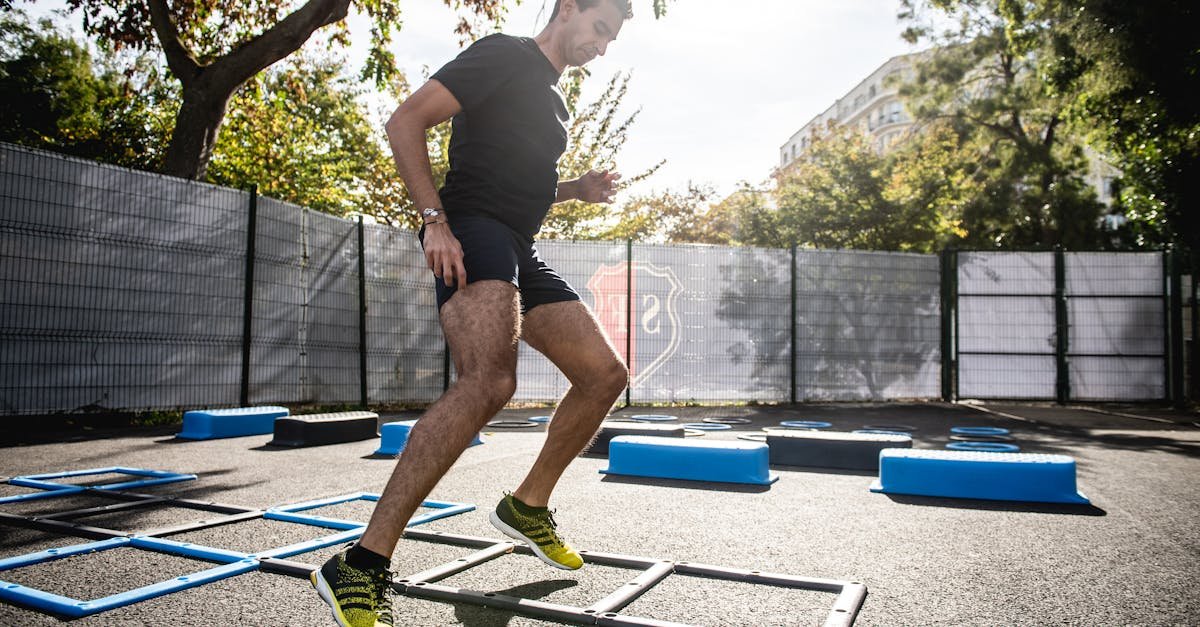Table of Content
- Build Endurance With Simple Cardio Drills
- What Exactly *Is* Endurance, Anyway?
- Why Keep it Simple? The Power of Basic Cardio
- Ready, Set, Go! Preparing for Your Endurance Journey
- Your Arsenal of Simple Endurance-Building Cardio Drills
- Drill 1: The Underrated Power of Brisk Walking
- Drill 2: Jogging or Running Your Way to Stamina
- Drill 3: Jumping Jacks – A Full-Body Wake-Up Call
- Drill 4: High Knees – Firing Up Your Core and Legs
- Drill 5: Butt Kicks – Dynamic Movement for Endurance
- Drill 6: Skipping Rope – More Than Child’s Play
- Drill 7: Stair Climbing – Using Your Environment
- Drill 8: Cycling – Indoors or Out
- Putting It All Together: Structuring Your Cardio Sessions
- Level Up! The Magic of Progressive Overload
- Listen Up! Tuning Into Your Body’s Signals
- Fueling Your Engine: Nutrition and Hydration Basics
- The Secret Sauce: Consistency Over Intensity
- Are We There Yet? Tracking Your Endurance Gains
- Conclusion: Your Journey to Better Endurance Starts Now
- Frequently Asked Questions (FAQs)
Build Endurance With Simple Cardio Drills
Feeling winded after climbing a flight of stairs? Wish you could play with your kids or grandkids without needing a break every five minutes? Or maybe you just want to feel more energetic throughout the day? If any of this sounds familiar, you’re likely looking to build your endurance. And guess what? You don’t need complicated routines or expensive gym memberships to do it. The secret often lies in simple, accessible cardio drills that anyone can incorporate into their life. Let’s dive into how you can boost your stamina and feel fantastic using exercises that are probably more familiar than you think!
What Exactly *Is* Endurance, Anyway?
Okay, let’s get on the same page. When we talk about “endurance” in this context, we’re primarily focusing on cardiovascular endurance (also called cardiorespiratory endurance). Think of it as your body’s ability to keep going during physical activity for an extended period. It’s about how efficiently your heart, lungs, and blood vessels work together to deliver oxygen-rich blood to your working muscles. The better your cardiovascular endurance, the longer you can sustain activities like walking, jogging, swimming, or dancing without feeling overly fatigued or out of breath.
Imagine your heart is a pump and your blood vessels are the pipes delivering fuel (oxygen) to the engines (your muscles). Good endurance means you have a strong, efficient pump and clear, wide pipes capable of handling increased demand. It’s not just about brute strength; it’s about the sustainability of effort.
More Than Just Running Marathons: Everyday Benefits
Sure, elite athletes need incredible endurance, but the benefits reach far beyond the finish line. Improving your cardiovascular endurance translates directly into a better quality of life. Think about it:
- More Energy: Paradoxically, expending energy through cardio actually gives you more energy for daily tasks. You’ll feel less drained by the afternoon slump.
- Easier Daily Activities: Carrying groceries, doing yard work, cleaning the house, playing with pets – all become less taxing.
- Improved Mood: Cardio exercise is a fantastic stress buster and mood booster, thanks to the release of endorphins (those feel-good chemicals).
- Better Sleep: Regular cardio can help regulate sleep patterns, leading to more restful nights.
- Enhanced Health: This is a big one! Good cardiovascular endurance is linked to a lower risk of heart disease, stroke, type 2 diabetes, high blood pressure, and even some types of cancer. It helps manage weight and strengthens your immune system.
- Increased Confidence: Accomplishing fitness goals, even small ones, builds self-esteem and makes you feel more capable.
So, building endurance isn’t just for athletes; it’s for anyone who wants to live a more vibrant, active, and healthy life. It’s about having the physical capacity to enjoy the things you love without being held back by fatigue.
Why Keep it Simple? The Power of Basic Cardio
In a world saturated with complex workout programs, high-tech gadgets, and boutique fitness classes, why advocate for simple cardio drills? Because simplicity works! Often, the biggest barrier to starting and sticking with an exercise routine isn’t the physical effort itself, but the perceived complexity or cost.
No Fancy Gym Needed!
One of the most beautiful things about simple cardio drills like walking, jogging, jumping jacks, or stair climbing is their accessibility. You don’t need:
- An expensive gym membership
- Fancy equipment (maybe a good pair of shoes, but often not even that!)
- A personal trainer shouting instructions
- A dedicated large space
You can do these exercises almost anywhere – in your living room, your backyard, a local park, or just around your neighborhood. This removes significant barriers related to cost, time (commuting to a gym), and intimidation that often prevent people from starting.
Getting Results Without the Complexity
Don’t mistake simple for ineffective. These basic movements, when performed consistently and with gradually increasing intensity or duration, are incredibly powerful tools for improving cardiovascular health and building endurance. Your heart and lungs don’t care if you’re using a $5000 treadmill or simply jogging in place – they respond to the demand placed upon them. Focusing on fundamental movements allows you to master the basics and build a solid fitness foundation without getting overwhelmed by complicated choreography or techniques.
Ready, Set, Go! Preparing for Your Endurance Journey
Alright, feeling motivated? Awesome! Before you lace up those shoes and dash out the door, let’s cover a couple of quick preparation steps. It’s like checking the oil and tires before a road trip – essential for a smooth ride.
Mindset Matters: Getting Your Head in the Game
Building endurance is a marathon, not a sprint (pun intended!). It takes time and consistency. Get ready to:
- Be Patient: You won’t double your stamina overnight. Celebrate small improvements along the way.
- Be Consistent: Aim for regular sessions rather than occasional heroic efforts.
- Be Kind to Yourself: Some days will feel harder than others. Listen to your body and don’t beat yourself up if you need to take it easier.
- Focus on How You Feel: While tracking progress is good, pay attention to increased energy levels and how everyday activities feel easier.
Adopt a mindset of progress, not perfection. Every little bit counts!
Quick Body Check: Are You Good to Go?
For most people, starting with low-to-moderate intensity simple cardio like brisk walking is perfectly safe. However, if you have any pre-existing health conditions (heart problems, severe arthritis, respiratory issues, etc.), are significantly overweight, or haven’t exercised in a very long time, it’s always wise to have a quick chat with your doctor before starting a new exercise program. They can give you personalized advice and ensure you’re starting safely.
Your Arsenal of Simple Endurance-Building Cardio Drills
Now for the fun part! Here are some fantastic, straightforward cardio drills you can use to build that endurance. Remember to start slow and gradually increase the duration or intensity as you get fitter.
Drill 1: The Underrated Power of Brisk Walking
Seriously, don’t knock walking! It’s low-impact, free, and incredibly effective. Brisk walking means walking fast enough to raise your heart rate and break a light sweat. You should be able to talk, but not sing.
How to do it: Find a safe place to walk (sidewalk, park, track, treadmill). Maintain good posture, swing your arms naturally, and step purposefully. Aim for a pace faster than a casual stroll.
Endurance Benefit: Consistently elevates your heart rate into the aerobic zone, strengthening your heart and improving lung capacity over time.
Making it Harder: Inclines and Pace
To boost the challenge, try walking uphill or increasing the incline on a treadmill. You can also pick up your pace or incorporate intervals – walk briskly for 3-5 minutes, then walk at a recovery pace for 1-2 minutes, and repeat.
Drill 2: Jogging or Running Your Way to Stamina
The next step up from brisk walking. Jogging is a fantastic way to significantly challenge your cardiovascular system.
How to do it: Start slow! Many beginners make the mistake of going too fast too soon. Aim for a pace where you can maintain a conversation, even if it feels really slow initially (this is often called conversational pace). Focus on landing softly to minimize impact. Again, find a safe route or use a treadmill.
Endurance Benefit: Provides a higher intensity stimulus than walking, leading to faster improvements in cardiovascular fitness and stamina for many people.
Tip: Try run/walk intervals. Jog for 1-2 minutes, walk for 1-2 minutes, and repeat. Gradually increase the jogging time and decrease the walking time as you get fitter.
Drill 3: Jumping Jacks – A Full-Body Wake-Up Call
An old-school classic for a reason! Jumping jacks get your heart rate up quickly and engage multiple muscle groups.
How to do it: Stand with feet together, arms at your sides. Jump your feet out wider than shoulder-width while simultaneously raising your arms overhead. Jump back to the starting position. Find a rhythm.
Endurance Benefit: Excellent for quick bursts of cardiovascular work. Can be incorporated into circuits or used as a warm-up or standalone drill.
Modification: For lower impact, step one foot out at a time while doing the arm movement (step jacks).
Drill 4: High Knees – Firing Up Your Core and Legs
This drill mimics the running motion but can be done in place, making it super convenient.
How to do it: Stand tall, feet hip-width apart. Drive one knee up towards your chest, as high as is comfortable, while swinging the opposite arm forward (like running). Immediately switch legs. Go for speed and height.
Endurance Benefit: Quickly elevates heart rate, improves coordination, and strengthens hip flexors and core muscles, which supports running endurance.
Tip: Start slower, focusing on form, then increase the speed as you get comfortable.
Drill 5: Butt Kicks – Dynamic Movement for Endurance
Another great drill that can be done in place, focusing on the hamstring part of the running motion.
How to do it: Stand tall. Bring one heel up towards your glutes, keeping your thigh pointing downwards. Immediately switch legs, moving at a brisk pace. Your arms can swing naturally as if jogging.
Endurance Benefit: Increases heart rate, improves leg turnover speed, and provides a dynamic stretch for the quadriceps.
Drill 6: Skipping Rope – More Than Child’s Play
Skipping is a phenomenal, high-intensity cardio workout that also boosts coordination and agility.
How to do it: Grab a jump rope sized correctly (handles should reach your armpits when you stand on the middle of the rope). Swing the rope with your wrists, not your whole arms. Jump just high enough to clear the rope, landing softly on the balls of your feet.
Endurance Benefit: Very effective at rapidly increasing heart rate and building cardiovascular and muscular endurance in the legs and shoulders.
Tip: If you don’t have a rope or are just starting, mimic the motion without the rope (“ghost jumping”). Start with short intervals (e.g., 30 seconds skipping, 30 seconds rest).
Drill 7: Stair Climbing – Using Your Environment
Got stairs at home, work, or in a park? Use them! Stair climbing is a serious endurance builder.
How to do it: Walk or jog up the stairs. Take them one or two at a time (two is more challenging). Walk back down carefully for recovery. Repeat.
Endurance Benefit: Combines cardio with leg strength work, significantly challenging your heart and lungs, especially on the way up.
Caution: Be careful coming down, especially if you’re fatigued.
Drill 8: Cycling – Indoors or Out
Whether on a stationary bike or exploring outdoors, cycling is a fantastic low-impact endurance builder.
How to do it: Adjust the bike seat to the correct height (slight bend in your knee at the bottom of the pedal stroke). Maintain a steady cadence (pedaling speed). On a stationary bike, adjust resistance; outdoors, tackle hills or vary your speed.
Endurance Benefit: Excellent for sustained aerobic activity, builds leg strength and endurance without pounding the joints.
Putting It All Together: Structuring Your Cardio Sessions
Okay, you have your drills. Now, how do you turn them into effective workouts?
How Often, How Long, How Hard?
- Frequency: Aim for at least 3-5 sessions per week. Consistency is crucial.
- Duration: Start with what you can manage, even if it’s just 10-15 minutes. Gradually increase the time by a few minutes each week, working towards 30 minutes or more per session.
- Intensity: How hard should you work?
- Talk Test: A simple guide. During moderate-intensity cardio (like brisk walking), you should be able to talk but not sing. During higher intensity (like jogging), you might only manage short sentences.
- Rate of Perceived Exertion (RPE): A scale from 1 (no exertion) to 10 (maximal effort). Aim for a 4-6 for moderate intensity and 7-8 for vigorous intervals.
A good starting point is 3 sessions per week of 20-30 minutes at a moderate intensity. You can mix and match drills within a session too (e.g., 10 mins walking, 5 mins high knees/butt kicks, 10 mins walking).
Don’t Skip the Warm-Up and Cool-Down!
These are non-negotiable!
- Warm-Up (5-10 minutes): Prepare your body for exercise. Start with light activity like slow walking or marching in place, then incorporate dynamic stretches (arm circles, leg swings). This gradually increases heart rate and blood flow to muscles.
- Cool-Down (5-10 minutes): Help your body transition back to rest. Slow down your pace gradually (e.g., slow walk after jogging). Follow with static stretches (holding a stretch for 15-30 seconds) for major muscle groups like quads, hamstrings, calves, and chest.
Level Up! The Magic of Progressive Overload
Your body is smart. It adapts to the demands placed on it. To keep improving your endurance, you need to progressively challenge yourself. This is the principle of progressive overload. It sounds technical, but it’s simple: you need to gradually make your workouts a little bit harder over time.
How can you apply this to simple cardio drills?
- Increase Duration: Add a few minutes to your walks, jogs, or cycling sessions each week.
- Increase Frequency: Go from 3 sessions per week to 4 or 5 (ensure adequate rest).
- Increase Intensity:
- Walk or jog faster.
- Add hills or inclines.
- Increase resistance on a stationary bike.
- Do drills like high knees or jumping jacks faster or for longer intervals.
- Decrease rest time between intervals (e.g., in a skipping workout).
The key is gradual increases. Don’t try to do too much too soon, as that can lead to injury or burnout. Small, consistent steps upward are the way to go.
Listen Up! Tuning Into Your Body’s Signals
While pushing yourself is important for progress, it’s equally vital to listen to your body. Pain is different from discomfort. Muscle soreness after a workout (Delayed Onset Muscle Soreness or DOMS) is normal, especially when starting or increasing intensity. However, sharp, sudden, or persistent pain is a signal to stop and potentially seek advice.
Pay attention to signs of overdoing it:
- Excessive fatigue that doesn’t go away
- Difficulty sleeping
- Decreased performance
- Increased irritability
- Persistent muscle or joint pain
- Elevated resting heart rate
If you experience these, take an extra rest day or reduce the intensity/duration of your workouts.
The Importance of Rest and Recovery
Your body doesn’t get fitter during the workout; it gets fitter during the recovery period after the workout. Rest days are when your muscles repair and rebuild, and your cardiovascular system adapts. Don’t underestimate the power of rest!
Aim for at least 1-2 rest days per week, or more if you’re feeling tired. Active recovery, like a gentle walk or stretching on rest days, can also be beneficial.
Fueling Your Engine: Nutrition and Hydration Basics
You wouldn’t expect a car to run well on an empty tank or dirty fuel, right? Your body is the same. While this article focuses on drills, remember that good nutrition and hydration are crucial partners in building endurance.
- Hydration: Drink water throughout the day, especially before, during, and after your workouts. Dehydration can significantly impair performance and make exercise feel much harder.
- Balanced Diet: Focus on whole foods – fruits, vegetables, lean proteins, and complex carbohydrates (like whole grains, oats, sweet potatoes). Carbs provide the primary fuel for endurance activities, while protein helps with muscle repair.
You don’t need fancy supplements, especially when starting. Just focus on staying hydrated and eating a balanced diet.
The Secret Sauce: Consistency Over Intensity
If there’s one takeaway message, it’s this: consistency trumps intensity every single time when it comes to building endurance. A perfect, super-intense workout done once a month won’t build endurance nearly as effectively as showing up for moderate workouts 3-4 times every week.
Life happens. You’ll miss workouts. You’ll have days where you feel unmotivated. That’s okay. The goal is to build a sustainable habit. Find activities you genuinely enjoy (or at least tolerate!), schedule your workouts like important appointments, and focus on just showing up. Even a short 10-minute walk is better than nothing. Build the habit first, and the endurance will follow.
Are We There Yet? Tracking Your Endurance Gains
How do you know if all this effort is paying off? Tracking your progress can be motivating and help you see how far you’ve come.
Ways to track:
- Workout Journal: Simply write down the date, type of activity, duration, intensity (RPE or talk test), and how you felt.
- Apps/Wearables: Fitness trackers can monitor distance, time, pace, heart rate, and more. They can be motivating but aren’t essential.
- Performance Metrics:
- Can you walk/jog further in the same amount of time?
- Can you cover the same distance faster?
- Does your heart rate recover more quickly after exertion?
- Can you maintain a higher intensity for longer?
- Do everyday tasks feel easier?
Focus on your own progress, not comparing yourself to others. Celebrate your improvements, big or small!
Conclusion: Your Journey to Better Endurance Starts Now
Building endurance doesn’t require a heroic effort or a complete life overhaul. By embracing simple, accessible cardio drills like brisk walking, jogging, jumping jacks, high knees, and others we’ve discussed, you can significantly improve your cardiovascular fitness, boost your energy levels, and enhance your overall quality of life. Remember the key principles: start slow, be consistent, listen to your body, apply progressive overload gradually, and don’t forget to warm up and cool down. Your heart, lungs, and muscles will thank you. The path to better stamina is right under your feet – are you ready to take the first step?
Frequently Asked Questions (FAQs)
1. How quickly can I expect to see improvements in my endurance?
You might start feeling subtle improvements, like everyday activities feeling slightly easier, within a few weeks of consistent training (3-4 times per week). More noticeable changes in your ability to sustain exercise for longer or at a higher intensity typically become apparent after 4-8 weeks. Consistency is key, and progress rates vary individually.
2. Can I build endurance just by walking?
Absolutely! Brisk walking is a fantastic and accessible way to build cardiovascular endurance, especially for beginners or those looking for a low-impact option. To keep progressing, focus on increasing your walking duration, speed, or incorporating hills/inclines over time.
3. Do I need special shoes for these cardio drills?
While you don’t need top-of-the-line gear, a comfortable, supportive pair of athletic shoes is recommended, especially for activities like brisk walking, jogging, skipping, or jumping jacks. Good shoes provide cushioning and support, helping to prevent discomfort or injury. Ensure they fit well and are appropriate for the type of activity.
4. What if I find these simple drills boring?
Variety can definitely help! Try listening to music, podcasts, or audiobooks during your workouts. Mix up the drills – create a circuit where you do 2 minutes of walking, 1 minute of jumping jacks, 2 minutes of high knees, etc. Exercise with a friend, explore different walking or jogging routes, or try incorporating something fun like dancing around your living room!
5. Is it better to do my cardio workout in the morning or evening?
The best time to exercise is whenever you can consistently fit it into your schedule! Some people feel more energized working out in the morning, while others prefer the evening to de-stress. There’s no universally “better” time for endurance benefits. Experiment and find what works best for your body clock and lifestyle.










